Let me begin this article by saying I have never been to the bottom of the sea in a submersible. I have seen one on the deck of a research vessel, but never taken the ride. The story I will share comes from a friend of mine from Dauphin Island Sea Lab who has made the trip.
We will begin with explaining the difference between a submersible and a submarine. A submarine is a ship – a vessel – they are large (100s of feet) – they dock in port – have a full crew (sometimes 100s of people) and goes to sea on its own. A submersible is much smaller (maybe 20 feet) – only has a crew of 2-3 people – and must be carried to the dive site by another ship (the “mother ship”). The reason for the size difference is pressure. Smaller, more spherically shape vessels can withstand more pressure. Though the exact dive depth of U.S. Navy submarines is classified, they cannot reach the ocean floor. Submersibles have made it to the deepest point of the sea – the Challenger Deep at the bottom of the Marianna’s Trench near the island of Guam. Yep… it is named after the first oceanographic research ship.
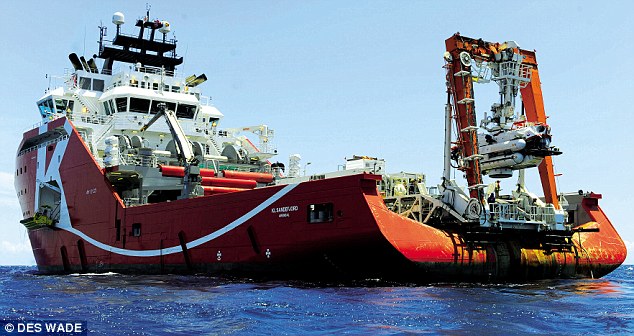
This might be a good place to discuss deep sea pressure.
The atmosphere is held to our planet like a blanket over you at night by gravity. It is pulling the air to the surface, and you are sort of in the way. This puts pressure on you by doing this. That pressure is 14.7 psi (pound per square inch). For each square inch of your body there is about 15 pounds of pressure pushing in. You do not feel this pressure because the eustachian tubes in your ears detect this and compensate for it – you push out with 15 psi. When you travel to the top of a mountain, or in an airplane, there is less air above you and thus less pressure. You feel this in your ears first and we “clear our ears” by yawning, chewing, something to adjust the internal pressure. In an airplane climbing to 30,000 feet, the pilot adjusts the air pressure within the plane. You sometimes feel it but usually they do it soon enough they you do not.
When you descend into the water you have not only all of the air above but now water as well – which is much heavier. You can feel the pressure on your ears even at the bottom of a swimming pool. At the surface, on the ship, we say you are at 1 atmosphere (1 ATM) – this is 15 psi. As you descend into the sea the pressure increases 1 atmosphere every 33 feet (10 meters). So, at 33 feet in the Gulf of Mexico, the pressure is 2 ATM (30 psi) – at 66 feet it is 3 ATM (45 psi) – at 1000 feet it is 30 ATM (454 psi) – at 10,000 feet it is 303 ATM (4545 psi) – and so on. Just as you feel the pressure on your ears driving up a mountain and clearing by yawning or chewing – you do the same as you descend into the sea… well… sort of.
#1 – The pressure increases MUCH faster due to the heavy mass of water. So, you can only go so deep before clearing will not help.
#2 – Most have a tough time yawning or chewing under water. Divers tend to clear by pinching their nose on the masks and blowing out slowly. Your ears will “pop” – clear. And then you can descend further. BUT only so far. At some point you can no longer clear, and the pain is too much. Most sport divers reach depths of 100 feet. Professional divers might be able to reach 300 feet.
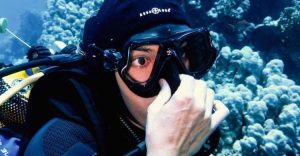
So… this would be the limit of ocean exploration if diving alone is used. And the oceans are 10,000s of feet deep. But as we have said, much of the marine life is closer to shore where the sun and nutrients are more abundant. So, coral reefs, kelp forests, and such marine habitats can be explored to depths of 100-200 feet.
But there is another problem…
How long can you hold your breath?
Maybe you can clear to 100 feet but how long can you stay there and conduct science?
Yep… we need air.
The first attempt to do this was using a diving bell. If you take a cup and invert into water, there is air space at the top of the cup. You can take a clear cup and do this in an aquarium, or in your bathtub and see it. If you could create a heavy cup – lower it to the bottom of the bay (maybe 20 feet) – swim down – you could go into this dive bell and find an air space. I have seen drawings of people doing this as early as the late 18th century. You do have to clear your ears, and there is a finite amount of air within the bell. Also – as you can see with your cup in the aquarium, if it tilts the air escapes. Game over.
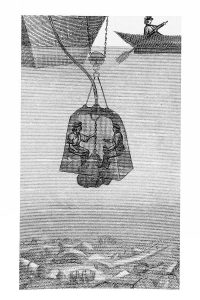
Image: U.S. Navy Science
It would be better if you could somehow provide air to this bell through a hose or something. And, in the 19th century, they did – what became hardhat diving. Instead of a heavy bell, they designed a heavy helmet. They were made of brass and had small windows so you could view the ocean floor. The front window could be opened while the deck of the ship, or on a dock, to breath fresh air. The suit was heavy canvas, and the boots were metal. There was also a weight belt that went over your shoulders to help get you to the bottom. There was an air hose that provided a constant flow of air and a regulator valve on the helmet so you could regulate how fast the air was supplied. They would assist you to the catwalk and into a metal basket that got you to the bottom. Sort of like an elevator. The air was supplied a machine developed during the industrial revolution called an air compressor. Now the diver could go underwater, clear by yawning or chewing, and explore the depths – as long as the depths were no more than 100 feet.
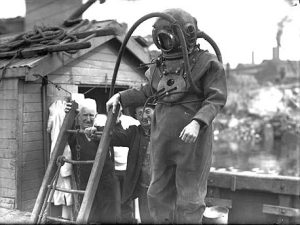
Early in the development of what would become known as compressed air diving, they discovered another issue. As the pressure increased on your body it would SQUEEZE the gases in the air you were breathing from your lungs and blood vessels into your tissues. Most of the air you are breathing is not oxygen, but nitrogen, and nitrogen in the body tissues – particularly the brain – could cause some problems. Excessive nitrogen gas on the nervous can cause hallucinations. Worse, if you come up too fast and do not allow this nitrogen to return to you blood vessels and lungs it would expand back into a gas with decreasing pressure – but in your body tissues. This can cause lung embolisms and cramping, or bending, of joints and limbs they call the bends. These conditions are life threatening. The deeper you go, and the longer you stay, the more dissolved nitrogen your body will experience. Prolong dives at depth can trigger nitrogen narcosis (the hallucination deal), and returning to fast can trigger the bends or a lung embolism.
So…
Divers have dive tables that tell them how long they can stay at selected depths and safely return. If you stay beyond that time – you must decompress on the way up. This means stopping at selected depths to allow the gases to expand in your lungs, not your tissues.
For some divers, like scientists or those working on oil rigs or deep-sea pipelines. They would sink a decompression chamber to the dive site. You could descend to the bottom – let’s say 100 feet – work beyond the allowed safe limit – let’s say 15 minutes – and instead of stopping and decompressing at different depths over the course of an hour – you would enter this decompression chamber at the bottom. The pressure at 100 feet is 4 ATM (60 psi). The pressure inside the decompression chamber is 4 ATMs. You go inside, the chamber is lifted back to the surface, but it is still 4 ATM inside. Here you sit inside and allow your decompression time to occur.
This all sounds dangerous, and it is, but with a thorough understanding of how this all works, and careful attention to detail, compressed air diving has allowed us to explore the shallow portions of the inshore ocean world. No one should try this without completing a dive certification course. You need to learn these details before you do this.
One problem these hardhat divers had was the life supporting cable that attached their helmets to the air compressor on deck. You could only explore as far as your cable would allow you to. Wouldn’t be great if there were no cable? But how would you get air if there were no cable?
Answer…
SCUBA…
SCUBA is an acronym for Self-Contained Underwater Breathing Apparatus. The idea is to use an air compressor to fill a cylinder made of sturdy material (the first were steel, now they are aluminum) fill the cylinder with enough air to last about an hour. Having that much air in this cylinder puts a lot of pressure on the tank – about 80 psi. The air in these things is pushing on the walls of the cylinder ready to explode. Cylinders must be hydrotested every five years to make sure they can withstand this pressure. If done, they are safe, but be careful handling them. You do not want to just throw them on the ground or anything, and you certainly do not want to place a full tank of air on airplane heading to an altitude of 30,000 feet!
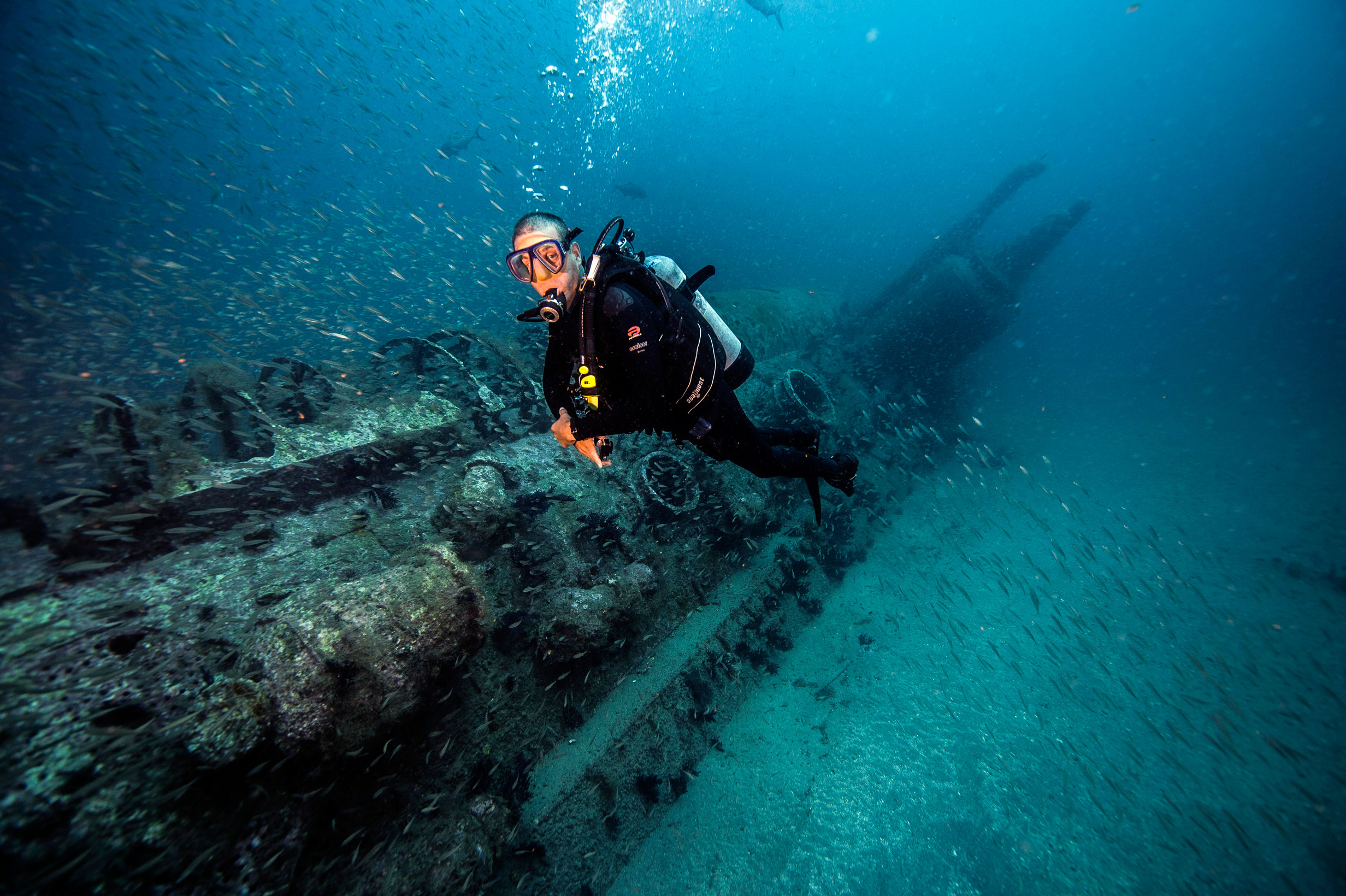
Photo: NOAA
The regulator that was on the helmet provided air at a steady flow at a rate that the diver was in control of. With SCUBA the regulator was re-conformed so that you received air only when you wanted it, and at an easy rate. The developer of this system was a French engineer named Jacques Cousteau. He became famous for his undersea exploration TV shows in the 1960s and 70s.

Photo: NOAA
With this SCUBA system on the divers back, and a pair of good fins, they could explore more of the ocean floor – at depths 100-200 feet. And explore they did.
But what is down at 500 feet? 1000? 10,000 feet? How do we get there safely?
Oceanographers and engineers began playing with this in the late 19th and early 20th centuries. Because of the physiology problems on the human body diving to great depths (nitrogen), the idea was to keep the diver at 1 ATM throughout the dive. If you could do this, then there is no decompression, no narcosis, no need to do safety stops, you would be at normal pressure throughout the dive. BUT if the inside of the “dive bell” was 1 ATM and the outside ocean pressure was 100 ATM there would be an obvious loss – the ocean would try to implode this “dive bell” – crush it. So, how to do this? AND who wants to be first?
The material first chosen was steel – makes sense, pretty strong. It was discovered during tests that the sphere was the best shape. There are few pressure points on a sphere and so it could withstand pressure much better. It was also discovered that small spheres can withstand more pressure than larger ones (hence the submersible – submarine deal) and so make it small enough for 2, maybe 3 people. Attach a cable to lower it, another one for air, and communication cables (a phone line) so the diver could talk to the “mother ship”. Thus was born the bathyscaphe. Dr. William Beebe was one of the first to descend in one of these off the coast of Bermuda in 1934. The reached a depth of 3000 feet and were able to describe the creatures they saw by the phone line to a National Geographic artist on the mother ship. 1 Atmosphere Diving was now part of ocean exploration.

Photo: Britannica
It was discovered in these early 1 ATM dives that steel was not as strong as they had hoped and so they had to find stronger materials to go deeper. They began to use titanium. There was also the issue of putting windows in these things. The development of Plexiglas (which can bend more than traditional glass) solved this problem. And, as with hardhat diving, the bathyscaphe was connected by a cable to the ship. Wouldn’t it be cool if you put a motor on this thing, disconnect once in the water, and drive it around. Yep… it would… and Yes… they did. The more modern deep-sea submersible was born.
The Alvin, from Woods Hole Oceanographic Institute in Massachusetts, is one of the more famous ones. It is the one that dove on the Titanic. It is the one that found deep sea vents and volcanoes. Though Alvin looks like a mini submarine – the area where the divers are is still a sphere. There is a fusiform shaped form placed around the sphere to give it the look it has, which moves through the water better than a sphere alone would. It is more aerodynamic if you will.

The one I have seen, and got to check out, is one of the Johnson SeaLinks. These are spheres made of six-inch Plexiglas with all sorts of equipment, monitors, and even a hardhat dive decompression chamber attached. It has an array of cameras, lights, sampling arms, vacuum cleaners, collection jars, anything you might want on the ocean floor – remember… you are at 1 ATM… you CANNOT open the door and go out. So, there must be some robotics to assist you with collecting. And pictures – takes LOTS of pictures. And video – take LOTS of videos.

Photo: NOAA
This is the submersible my friend Mike made a dive in. He tells the story like this…
The night before the dive, while at sea, the technical crew goes over every square inch of the machine to make sure all systems work and there are no problems at all. In the morning, you climb up and in the tight sphere into your seat. The pilot operates the electric motors and robotic collecting equipment. The camera takes photos on a timer. He starts the video when you – the scientist – tells him to.
Once in and a thumbs up is given. The winch lifts the submersible out of its carriage. It swings it – carefully – over the side. Mike said this was the worst part of the whole trip. You are swinging on a cable and the ship is slightly rocking back and forth. You can get nauseous at this point.
The submersible is eventually in the water and the nauseous feelings go away. There are free divers in the water swimming around checking things out. There is the pilot talking to comms on the mother ship going down a check list. At that point you get the all clear to go and give the thumbs up to the free divers. They respond with a thumbs up and disconnect you from the mother ship – you are on your own now.
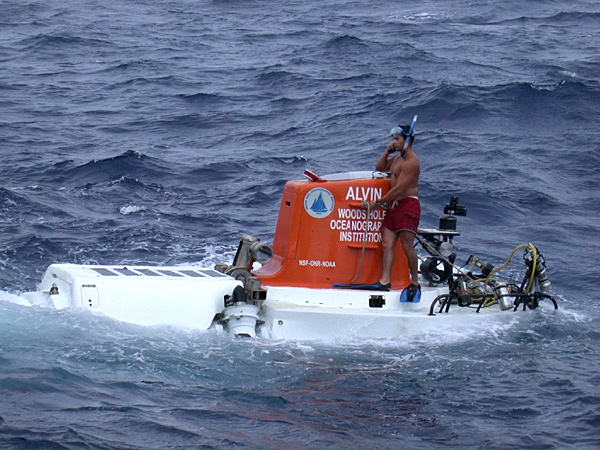
Photo: NOAA
Mike said the view and ride were amazing. In this Plexiglas sphere you could see almost 360° around you. All sorts of fish swimming by and – of course – the cobalt color of the Deep Blue. As you descend, he said he goes from the cobalt blue to a deep indigo color. Light becomes less and the temperature lowers as well. At one point Mike said he felt a drop of water. Then another. He looked up and there was water dripping on him. His initial thought was “MAN! This thing has made 100s of dives and the ONE day I get on it is leaking!” The pilot saw his concerned and told him – “no worries – its condensation… it is much colder outside of the bell”. It eventually stopped and the dive continued.

Photo: NOAA
Eventually you are in complete darkness and the lights are turned on. Much of the marine life flees, but you can see all sorts of strange and beautiful creatures. Strange squids, all sorts of jellies, long stringing crab looking things, eel-like fish. Eventually the rocky bottom comes into view and you see even more life. Mike said these submersibles are great for exploring – the ride is awesome – but for science it is limiting. You have a hard time collecting the moving creatures. The submersible is slow, and they quickly swim away from the strange lights they have never seen before. He said when you cut off the lights the world illuminates. Much of the deep-sea creatures are bioluminescent and create their own light. If you are collecting rocks, or in Mike’s case – corals, the submersible works well.
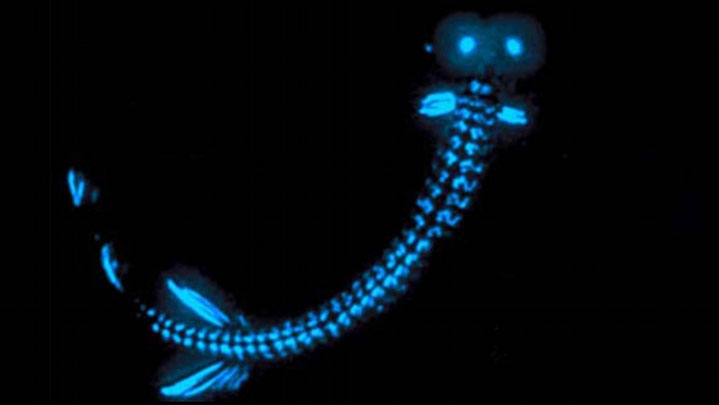
Photo: NOAA
After an hours or so on the bottom it is time to return. You move from the blackness to the violet and indigo and back to the cobalt blue. You see the brightness of the sun through the water and the free divers waiting for you. You are reconnected and lifted back into the carriage. You exit the ship with no decompression stops needed and an exhilarating smile on your face.
Sea stories…
During one of the evening trawls my roommate on the cruise brought a mushy looking creature that was brought up from the depths. He had it in a plastic tub and was showing it to me. As he brought it in, he said “watch this” – he turned the lights off and shook the plastic tub. The mushy looking thing began to give off a mesmerizing light show. It was a cool blue color and radiated in pulses like a neon sign. It was VERY cool!
Bioluminescence is the rule in the deep-sea. Many of the creatures there produce their own light, or harbor bioluminescent bacteria in their skin. The lights show the way and communicate. It was very cool.
 3
3
